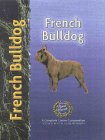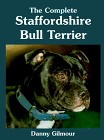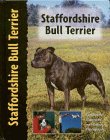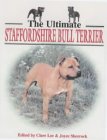| Breed profiles
Dog Breeds: Bull Dogs and Bull Terriers
If you want to buy a book, clicking on the book cover
will take you directly to that book on the Amazon.co.uk web site.
See also:
 Dogs:
Breed profiles and breed books Dogs:
Breed profiles and breed books
 Dogs:
Health and Nutrition Dogs:
Health and Nutrition
 Dogs:
General Dogs:
General
 Dogs:
Origins, canine evolution and wolves Dogs:
Origins, canine evolution and wolves
 Training, puppy and adult dog good manners Training, puppy and adult dog good manners
 Advanced training, including gundog training Advanced training, including gundog training
 Fiction
and biography relating to dogs Fiction
and biography relating to dogs
 Click
here for bulldogs and bull terriers on stamps Click
here for bulldogs and bull terriers on stamps
|
Click on the above image to see more
stamps featuring dogs
|
General overview
Bull Dogs and Bull Terriers, including Boxers and all breeds with bulldog-like
ancestry in common. Old-style Bulldogs were bred for bull baiting, with a
mix of mastiff and terrier, so they were courageous and tenacious dogs, with
powerful jaws. Modern Bulldogs (also called English Bulldogs) are less aggressive
than their ancestors, and also have more health problems. Modern Bull dogs
have broad heads and squashed noses (they are 'brachycephalic') which means
that they may suffer breathing problems because their nasal passages are relatively
foreshortened. Bull dogs can also suffer from extremes of cold and heat, and
especial care should be taken in summer to ensure they are not affected by
heat stroke. Bulldogs may also have to give birth via caesarian operations
because of their broad heads, so this breed is not well designed for survival!
Boxers, too, are prone to a whole host of health problems, from incontinence
to cancer, and anyone buying a boxer pup should ask searching questions of
the breeder about the longevity and health of the pup's ancestors. White English
Bull Terriers are also prone to inherited ailments, though Staffordshire bull
terriers tend to be relatively healthy.
Staffordshire Bull Terriers are especially popular in the UK. They are similar
to pit bulls, and regularly appear in news reports of serious dog bites, yet
they are also nicknamed 'The Nanny Dog', because they can get on so well with
children. Few breed types raise so much passion, both among their supporters
and their detractors. So what is the truth about Bull Dogs and Bull Terriers?
Training and supervision are very important for all breeds, but this is especially
true for Bull Dogs and Bull Terriers. They are muscly, powerful dogs, which
tend to like rough play, and act with a puppyish exuberance all their lives.
Owners and dogs benefit if bully breeds start training as soon as possible.
These breeds can pull hard if not taught how to walk nicely. They also need
to learn to drop objects on command, and to 'leave' other dogs and forbidden
objects. Owners still need to watch interactions with other dogs, because
'leave' may not be enough if a bully breed dog has decided to fight, and once
a fight has started, dogs tend not to hear their owners. Training recall is
important, so that owners can prevent trouble by calling the dog to them.
Any owner who neglects to train a bully breed is asking for trouble. Owners
also sometimes think it fun to encourage their dogs to hang on to objects,
while neglecting to teach them the 'drop' command. Bad move! You do not want
a strong jawed dog who has been taught that not letting go is a good thing.
Do teach them tug, by all means, but as a way of teaching 'drop', and as soon
as you say 'drop', the dog should let go of the tug. Patience, firmness and
consistency are important with bully breeds, as with all breeds. Being firm
means setting rules from when the dogs are pups, and making sure the dog understands
them. Bully breeds can be both sensitive and stubborn, so clumsy attempts
to 'show them who's boss' can be counter-productive. Boxers can be especially
sensitive, and stop listening if they are roughly treated or confused about
what they are meant to be doing. It's more helpful to persuade bully breed
dogs that your way is the best way. As they tend to be affectionate dogs,
and love to be with people, very short time-outs can be very effective to
show them you disapprove of some behaviour.
Good manners are best taught from puppyhood, because it's easier, but adult
rescue dogs can still learn fast. The best time to teach good manners to a
rescue dog is as soon as the dog arrives. That is when the dog is watching
you to learn what the rules are. It's tempting to spoil the dog a bit, because
you feel sorry for him or her. But it's kinder in the long run to let the
dog know gently and firmly what you consider to be appropriate behaviour.
Rescue centres usually have their own behaviourists and provide ongoing help
for adopters. Gwen Bailey's 'The Rescue Dog' is also full of good advice.
Pups of bully breeds chew, as all pups do, only bully breeds can cause more
damage, so you do need to puppy proof your home extra carefully, and provide
a lot of legitimate chewing objects.
Bully breeds can be dog-aggressive, if not socialised properly, and even
well-socialised dogs may suddenly decide on adolescence that the best way
to deal with other dogs is to fight them. Bully breeds are not quick to take
offence, but if they do get into a fight, they tend not to give up, and their
powerful jaws can do a lot of damage. They benefit from puppy socialisation
classes, and being matched with dogs that can teach them appropriate play
styles and good canine manners. Other dogs often have trouble in 'reading'
the relatively impassive faces of bully breeds, and may provoke them beyond
their trigger point without realising it. Owners of other dogs may also have
trouble understanding your dog's body language, and be convinced that your
dog really wants to be friendly with their dog, when you know that this is
far from the case! A wagging tail does not always mean benevolent intentions,
especially if the dog has stiffened, and the tail is wagging slowly.
Bully breeds can get on well with other dogs in the same household, so long
as the dogs are well matched, and introductions are carried out carefully.
This means allowing the dogs to meet first on neutral ground, and making sure
that the two dogs can be given time out in separate rooms if necessary. Bringing
in a pushy adult dog into a home with an unsocialized bully breed dog used
to being an only dog is asking for trouble, especially if the two are forced
to interact by being shut together in a small room, whatever their feelings
for each other. It's easier to bring in a bully breed as a pup, and have the
existing adult socialise the dog. They are best matched with the more robust
and calmer breeds, which can handle rough play, while toning down the bully
exuberance. More than one bully breed dog can be kept in the same household,
though this does need skill on the part of the owner, and dog-bitch combinations
tend to work better than two dogs of the same sex.
What about children? This depends a lot on the dog and the children. A well-trained
bully breed can be marvellous with children, so long as the kids know how
to behave with dogs, and don't let them get too excited. Small children and
dogs should always be supervised, and neighbouring children who come to play
in your house also need to know that dogs should be respected. It's important
to 'proof' your bully breed pup against shouting, running children, and kids
on bikes, so that they do not act as a trigger for overexuberance and even
aggression when the pup becomes an adult. Untrained bully breeds together
with untrained kids are a recipe for disaster, something that is true for
any breed, but especially for energetic dogs that can knock kids over, and
which have strong jaws. However, trained bully breed dogs and sensible children
can get on wonderfully well, since bully breeds are generally very tolerant
dogs, robust enough not to worry about children, and with enough energy to
keep up with them.
Breed Profiles

Click on the cover above
to go to this book
at Amazon.co.uk
|

The Boxer Handbook
Walker
Barron's Educational Series
ISBN: 0764112449
Boxers are lively dogs that never seem to grow up. They learn well,
if trained with patience and consistency, and despite looking like well
muscled 'toughies' to some people, they are sensitive and affectionate,
so can switch off if they are shouted at in training. They need careful
training and socialization as pups, because of their tendency to be
a bit rough with other dogs and people. Humans can be knocked over by
an unexpected friendly greeting from a Boxer, so they need to be taught
not to jump up, and should only get cuddles as pups when all four paws
are on the ground. Not all dogs like their style of playing. Boxers
will sometimes box with other dogs, and there are dogs who enjoy rough
games with Boxers, especially individuals from other medium-sized breeds
who, like Boxers, continue to be playful all their lives. It is, however,
wise to socialize Boxer pups with dogs that have gentler styles of playing,
so that the Boxers learn how to play gently as well as roughly, and
so that they learn to differentiate between dogs that like rough play,
and those that don't.
Boxers aren't especially barky, but they are good guard dogs, simply
because they can look serious and imposing, though well-socialized Boxers
usually like visitors who give them a friendly greeting, since they
are generally outgoing dogs.
Are Boxers good with children? They can be excellent companions for
children, so long as they have been well-trained as pups. They are a
little strong and lively for many children to handle on walks, and can
even be too strong for many adults, since they can pull hard if they
see a canine or human friend or other attraction.
The biggest drawback with this breed is that they are susceptible to
a range of health problems, especially cancer, which can cut short their
lives, so anyone buying a puppy should ask about longevity in the parents'
lines. Other conditions that can affect Boxers include hip dysplasia,
heart trouble, epilepsy, spay-related incontinence, and allergies. They
may also have breathing trouble due to their short muzzles, and may
snore and drool. White Boxers are especially prone to health problems,
including deafness. Boxers can feel the cold easily, because of their
short coats, but don't need much grooming.
The Boxer Handbook is a very good introduction to the breed, dealing
with general care as well as health issues. It is suitable for novice
owners with their first Boxer.
 Top
of page Top
of page
|

Click on the cover above
to go to this book
at Amazon.co.uk
|

Boxer
Edward Winston Cavanaugh
Interpet
ISBN 0966859251
This is a very useful guide to Boxers, which can help would-be and
existing owners avoid many problems. It is clear enough for novices,
as well as providing enough information to be of use to experienced
owners. It is also very well illustrated, with numerous photographs.
 Top
of page Top
of page
|

Click on the cover above
to go to this book
at Amazon.co.uk
|

Collins Dog Owner's Guide: Boxer
Peter Neville
Collins
ISBN: 0004133706
A short guide to boxers from respected British behaviourist, Peter
Neville. It's very good as far as it goes, and will certainly help a
novice, but experienced owners will find little that they don't already
know about Boxers.
 Top
of page Top
of page
|

Click on the cover above
to go to this book
at Amazon.co.uk
|

Boxers for Dummies (For Dummies)
Richard Beauchamp
Hungry Minds Inc
ISBN: 0764552856
An up-to-date and in-depth account of the breed, which goes into Boxer
history in some detail, and offers good advice on general care and training,
including nutrition and health problems. It's very readable, despite
being packed with information.
 Top
of page Top
of page
|

Click on the cover above
to go to this book
at Amazon.co.uk
|

Bulldogs Today (Book of the Breed)
Thomas
Ringpress Books
ISBN: 1860540058
Bulldogs, also called English Bulldogs, are often cited as a walking
example of the harm done to dogs by people breeding for appearance.
These dogs tend to have nice natures, but suffer from a range of health
problems, including breathing trouble from their squashed noses, and
an inability to give birth without a caesarian in many cases, due to
their big heads. They also don't walk easily, but rather tend to waddle,
and may suffer from hip and knee trouble. They both feel the cold and
suffer when it's hot, and can suffer from skin problems. Their facial
wrinkles need regular cleaning. Bulldogs also have a tendency towards
flatulence, and soya-based foods can exacerbate this. Their health problems
mean that Bulldogs tend not to live as long as the other bully breeds,
such as Bull Terriers.
Modern English Bulldogs are a different beast from the original Bulldog,
which was both healthier, and more aggressive. Modern Bulldogs are usually
calm and gentle, and can be good companions for children because they
are generally tolerant and affectionate, and love attention. However,
like all bully breeds, they can be headstrong, and need socialization
and training from when they are pups, because of their potential for
causing damage when things do go wrong. The breed's headstrong nature
means that it can be too much of a handful for novice dog owners. People
who already have experience of dogs should perhaps think long and hard
about the health problems of this breed, and whether it is a good idea
to perpetuate breeding for appearance when this results in a dog which
has problems that threaten its survival. However, Bulldogs do have a
special appeal because of their combination of strength and gentleness,
courage and affection, and their slow gait is an advantage for many
older people who have no desire to go jogging with a Saluki. Bulldogs
sometimes need to be persuaded to take exercise, especially as they
get older and their joints get creakier, but regular walks are good
for them.
This book is a good introduction to the breed, which is well illustrated
and gives a lot of help with general care, including health care. It
gives a good picture of the breed and explains the appeal of the Bulldog
personality well. However, breeders who write books are more likely
to give a rosy picture of their breed. Anyone considering a Bulldog
should read more than this guide, and do a great deal of research on
their health problems, looking at a range of sources, and talking to
vets with experience of the breed.
 Top
of page Top
of page
|

Click on the cover above
to go to this book
at Amazon.co.uk
|

Bull Terrier
Bethany Gibson
Interpet Publishing
ISBN: 190238928X
Bull Terriers, also sometimes called English Bull Terriers, were bred
for dog fighting, and were created from breeding terriers with ancestors
of bulldogs. Bull Terriers are striking looking dogs. They are bigger
than Staffordshire Bull Terriers, and have longer muzzles and no stop,
rather the top of their heads slopes gently. This gives them a generally
more dignified air than Staffies, though they also have a distinctly
quirky appearance, and love to clown. Bull Terriers have some similarities
to Staffies in character, being courageous, active and playful, though
they tend to be calmer. Like Staffies, they are active dogs, which need
attention and something to do, or they tend to do things you would rather
they didn't, like chewing the furniture, if they are left alone all
day. Like Staffies, Bull Terriers also need to be socialized carefully,
both with people and other dogs, and have house rules laid down from
when they are pups. Bull Terriers can be very headstrong, hence the
need to be consistent about house rules. They should be trained to be
calm around children with bicycles, since otherwise they can get over-excited,
as a high-profile UK court case has shown! This takes time, since the
breed has a tendency to want to join in any exciting activity which
is happening, so it's safer to keep them on the lead when walking them
anywhere near playing children. They are very fast movers, and it is
difficult to stop them once they are in full flight, though a well-trained
Bull Terrier should obey a recall command if given before they start
a charge! Bull Terriers also need to learn the command 'leave' from
when they are pups, and to be taught to drop objects on command when
they are little. The drop command can be reinforced through tug games
which incorporate a 'drop', a 'sit' and a throw.
Bull Terriers are affectionate and like attention, which helps in training
them. Well-bred, well-trained and well-socialized Bull Terriers that
have enough exercise are usually very good with children, both tolerant
and gentle, but individuals that don't get enough exercise are likely
to be very bouncy, and can easily knock small children over. Visiting
children who are sensible generally get on well with Bull Terriers,
though adult supervision is needed in case the dog gets overexcited
with children screaming and running, or children unwisely decide to
tease the dog. Bull Terriers have strong jaws which can do a lot of
damage.
Any breed created for dog fighting has more potential to become dog-aggressive.
Well-socialized bull terriers can get on very well with some other dogs.
They can enjoy playing games with other dogs of more robust breeds,
and can be very calm when being yapped at by other dogs. It's not that
Bull Terriers are quick to fight, on the contrary, they tend to be relatively
calm. The problem is more that if Bull Terriers do fight seriously,
they can do more damage than most dogs, and because other dogs sometimes
have trouble 'reading' their body language, dogs they meet don't always
know when to back off and stop harassing a Bull Terrier. Dog walkers
you meet may also blithely tell you their pushy dog is friendly, and
not see stiffening and other indicators that your Bull Terrier does
not appreciate a pushy dog in his face, so you may need to practise
ways of discouraging imprudent walkers from doing this. It is safer
to keep Bull Terriers on the lead if they are walked where they are
likely to meet strange dogs, because of their potential for aggression
against other dogs, even if they appear friendly as youngsters, since
aggression against other dogs does not always appear until Bull Terriers
are adults. They can be left off the lead for supervised play with dogs
they have always got on with. It's safer to get a dog and a bitch if
you get more than one Bull Terrier.
They don't need a lot of grooming, as a short-haired breed, but can
be barky. This is a good thing if you want a watchdog, but can create
problems with neighbours if uncontrolled. Dogs that have enough exercise
generally bark less.
There is a miniature version of the Bull Terrier which can be somewhat
less reliable in terms of temperament. As always, when dogs are bred
for looks, temperament and health become less of a priority. The white
version of the standard size Bull Terrier is also prone to more health
problems than the coloured version. Inherited health problems that are
particularly likely to affect white Bull Terriers include deafness,
skin disorders, and heart disease. Both white and coloured versions
can be affected by deafness and skin trouble, however, as well as kidney
trouble, allergies, including skin allergies which may be flea-related,
knee and eye problems, digestive problems which can affect zinc metabolism,
and behavioural quirks such as repetitive behaviour, though this is
more likely in bored individuals.
The book gives an account of the history of the breed, and gives a
good description of its character, dealing with both the good and less
desirable Bull Terrier traits. There is advice on general care of Bull
Terriers at all stages of their lives, from choosing a pup to the needs
of older dogs. The book is well-written, and should appeal to novices
for its clarity and help with training. It's also informative enough
to appeal to experienced Bull Terrier owners. It's an entertaining book,
which is well-illustrated.
 Top
of page Top
of page
|

Click on the cover above
to go to this book
at Amazon.co.uk
|

French Bulldog (Pet Love: Special Rare Breed Edition)
Muriel P. Lee
Interpet Publishing
I SBN: 1903098661
French Bulldogs are the smallest of the bully breeds on this page,
usually just a little smaller than Staffies. They look endearing with
their bat-ears, big eyes and round foreheads They are generally affectionate,
sweet natured and playful.
French Bulldogs are easier to train and handle than most bully breeds.
Like many bully breeds, they do need attention, and aren't dogs to leave
alone all day, and they can also be headstrong. Dogs of this breed often
become more attached to one person in the household, while getting on
well with the rest of the family. They tend to do very well in training
if owners are consistent in making house rules clear from when the dogs
are pups. French Bulldogs tend to get on better with older children,
and are a little small for households with younger children, who might
try to take liberties with them. They get on better with other dogs
than do most bully breeds, though they can take a dislike to some other
dogs, and socialization with other dogs is, of course, important.
These dogs don't need a lot of grooming, as a short-haired breed. They
don't bark a lot, just enough to be good watchdogs, giving sharp barks
to alert their owners when strangers appear. They aren't good guard
dogs, since they are so small, and tend to be friendly with most people
they meet.
Common health problems include eye trouble from their prominent eyes,
and breathing trouble from their short muzzles, which can also mean
they snore. Flatulence can also be a problem, and they should not be
allowed to become overweight. Like most bully breeds, they are sensitive
to both cold and heat, so may need a coat in winter, and should not
be exercised in the heat of the day in summer. Bitches can have trouble
giving birth, as happens with English Bulldogs.
Muriel Lee has written a very good introduction to this endearing breed,
drawing on her extensive experience of bully breeds. It's clearly written,
and gives a very good idea of what it's like to live with a French Bulldog.
 Top
of page Top
of page
|

Click on the cover above
to go to this book
at Amazon.co.uk
|

New Owner's Guide to Staffordshire Bull Terriers
Dayna Lemke
TFH
ISBN: 0793827922
Staffordshire bull terriers are small, powerful dogs, which are deservedly
popular for their amiable and lively natures. They can also be a handful,
and need proper training and supervision. They are not a breed to take
on without owners being prepared for a lot of commitment, as any rescue
centre will tell you. They want someone to be devoted to, and if it's
a family, even better.
Stafford owners know that these dogs love people, affection and comfort,
and can be very placid and tolerant with children, yet they also appear
a lot in press reports of dog bites. So why is it that a dog nicknamed
the 'children's nanny' gets such a bad press? Stafford lovers point
out that press reports aren't always accurate. Bites by Stafford and
rottweilers are 'news', more so than bites by mongrels, so if a dog
looks vaguely like a Stafford, it will tend to be reported as such.
There is also the problem that any dog which isn't properly socialized,
trained and supervised can be a menace, especially if it has powerful
jaws. Staffords in fact are one of the most tolerant breeds where children
are concerned. They aren't easily spooked by kids rushing around and
screaming, and generally taking liberties with them. However, they can
be 'mouthy' dogs, and need to be taught from puppyhood that mouthing
people, especially children, is unacceptable. They are also fast-moving
dogs, and aren't easily frightened, so can rush into trouble. It's not
easy to call them back once they have started a headlong rush towards
something that interests them. Your dog may simply be too interested
in what he is doing to hear you. Staffordshire bull terriers are one
of the breeds most vulnerable to being killed in traffic accidents.
To keep your Stafford safe, the garden or yard has to be secure, with
a high enough fence to prevent escapes, and lockable, so that no-one
is likely to come in and leave the gate open. It's also safer to keep
your Stafford on a lead if you are anywhere near a children's play area,
or a busy road, even if you think your dog's recall is pretty good.
Staffordshire bull terriers were designed to be family dogs, and the
breed is generally friendly and outgoing with people. It's important
to check the temperament of the parents of any Stafford pup you are
interested in - it is not a good idea to buy a Stafford pup just because
it is cute. It's worth seeing the mother, and finding out something
about the father's temperament. You may not be able to meet the father,
if the breeder has sought an especially good stud from a long way away,
but you can find out a lot by asking about the qualities that made the
breeder seek a particular stud. It's also worth asking about what efforts
the breeder has made to socialise the pups, and get them used to living
in a home with humans. Good breeders won't mind if you ask questions.
However, many fine Staffies of unknown parentage have come from rescue
centres. Rescue dogs are generally vetted thoroughly, and if you choose
a good rescue centre, they should be able to advise on whether you and
a particular Stafford are compatible.
Once you get your Stafford home, his training can start. He is learning
all the time from the people he meets, and what he is allowed to do,
so let him know from the start what you want of him, for example, what
he is allowed to chew, and where it is allowed to lie. Pups need to
learn how to behave with children, and this includes learning to be
gentle with them, greeting children nicely. It's easy to pet your pup
when he jumps up for a cuddle because he looks so cute, but it's safer
to stick to the rule of no cuddles unless all four paws are on the ground.
Children are usually very curious about puppies, so you can use encounters
with children on walks as opportunities for lessons, if you don't have
children of your own. It's also helpful to teach your pup to behave
well with adults of different appearances, including postmen and meter
readers, so that he is friendly with everyone as an adult.
Teaching bite inhibition starts when pups are small, by letting them
know that nips and mouthing are not acceptable. A short 'time out' can
help control nippiness, in fact pups often get nippy when they are overtired,
and need some sleep, just as small humans can become fractious when
they are overtired. Giving pups something to chew on other than people
also helps, if your pup decides it's fun to chew you, in a moment of
boredom. Stafford pups like exploring the world with their mouths, and
you might find this amusing, but someone who doesn't know your treasure
may not! If you always offer a chew toy when your pup starts mouthing
you, this can help get the pup out of the habit. Stafford pups tend
to chew a lot, so need a plentiful supply of chew toys. These should
be robust, since fragile expensive toys can be demolished fast, especially
squeaky toys! It's cheaper and more practical to make homemade toys
out of thick cardboard, or rolls of jeans cloth twisted together and
knotted.
Staffords like rough play, but you need to stay in control. They thrive
on affection, so, again, short time-outs are a good way of letting them
know when they get too manic. They also love tug games, which are fine,
so long as you teach them the 'drop' command as part of the tug game.
It is very difficult to take objects from the mouth of an adult Stafford
that hasn't been taught to drop objects on command, and that thinks
your attempts are just part of a fun game of tug! You can teach 'drop'
by offering the pup something to take, then offering something he values
more, saying 'drop' when he relinquishes the first object. 'Trading'
can also help when a pup takes an object you'd rather he didn't. Again,
if you say 'drop' when he drops the forbidden object, he gets the idea
of what 'drop' means. Simply trying to pull a forbidden object out of
a Stafford's mouth is not generally a good idea. The pup may think it's
a game and grip the object harder. Once the pup has learnt the 'drop'
command it can be incorporated into all sorts of games, to reinforce
it. Staffords can learn to enjoy retrieve games, for example, and these
involve giving up an object in order to get you to throw it.
Staffordshire bull terriers can be stubborn, but they are also intelligent,
and soon realise when it's in their interests to obey you. Being consistent
helps a lot, so that your pup realises that jumping up doesn't bring
cuddles, and mouthing people is not allowed! It's well-worth aiming
for a rock-solid recall, practising in a safe, enclosed area. Even if
you don't achieve this, practising gives you a much better chance of
calling your dog out of trouble if he slips the lead when you are out
walking, or dashes out of the front gate. If you teach your pup the
basics, how to behave round children, to sit, stay, come back on command,
walk politely past other dogs and to go to his place when guests arrive,
he will be a fine ambassador for the breed. Training classes are very
useful, once your Stafford is old enough, and if he already knows the
basics, you are both likely to enjoy training classes that much more.
Staffordshire bull terriers are not ideal guard dogs. They are barky
dogs, so can be good watchdogs. They will give warning barks, which
should be enough to deter most intruders. However, after having barked,
well-socialized Staffords may then be very friendly with unwanted strangers
who approach them in the right way. They are certainly not dogs to leave
outdoors unattended. They have relatively thin coats, so feel the cold,
and are 'people dogs' so prefer to be with their human families. Because
these dogs can be so friendly with strangers, there is also a risk of
Staffords being stolen, if they are left outdoors unattended.
This breed was descended from ancestors developed for dog fighting,
and this means that fights can be a problem. Many owners say that Staffords
are best kept as single dogs, rather than in multi-dog households, and
should never be left with other dogs unattended. This is a popular breed,
with a large gene pool, so there is a great deal of variation between
individuals. You may feel that your particular Stafford is placid and
a softie, and would never scrap. Even so, it's safer not to take on
a companion for your Stafford unless you know the breed very well. Generally,
opposite sex mixes of dogs of different ages are safer than keeping
two dogs of the same sex that are close in age. The problem isn't so
much that Staffords are quick to take offence - they can be quite tolerant
with other dogs - it's more that once Staffords do decide to fight,
they can inflict a lot of damage, and may not give up easily. Socialization
with other dogs is, of course important, but even well-socialized Staffords
may take a dislike to some dogs they share a house with, or meet on
walks. It's safer to keep them on the lead if they are being walked
somewhere where there are a lot of other dogs.
Staffordshire Bull Terriers are more prone than average to accidents
because they are bold, fast-moving dogs. This applies especially to
young Staffords, but if you can keep them out of trouble when they are
youngsters, they tend to be active and healthy most of their lives.
Common health problems include eye trouble and tumours.
 Top
of page Top
of page
|
|

Pet Owner's Guide to the Staffordshire Bull Terrier
(Pet Owner's Guide)
Clare Lee
Ringpress Books
ISBN: 1860540821
This is a very good introduction to Staffordshire bull terriers, which
explains some of their more challenging characteristics. The information
and the photographs in this book are good, and it's clearly written,
but it is a slim volume - you will find yourself wanting more!
 Top
of page Top
of page
|

Click on the cover above
to go to this book
at Amazon.co.uk
|

The Complete Staffordshire Bull Terrier (Book of the
Breed)
Danny Gilmour
Ringpress Books
ISBN: 0948955694
Danny Gilmour is an experienced Staffie man, and has written a very
good book of the breed, with help on breeding as well as general care.
He places a lot of stress on breeding for temperament, as well as training.
The illustrations are good, as is the account of the breed history.
The content is very good, the only grumble is that this book is quite
expensive for a relatively short work.
 Top
of page Top
of page
|

Click on the cover above
to go to this book
at Amazon.co.uk
|

Staffordshire Bull Terrier (Pet Love)
Jane Hogg Frome
Interpet Publishing
ISBN: 0966859294
A very good introductory guide to Staffordshire Bull Terriers.. There's
help with showing and training Staffies, and understanding their behaviour,
as well as with general care. It is perhaps not meaty enough for experienced
owners, but certainly covers the basics well, and it has nice pictures.
 Top
of page Top
of page
|

Click on the cover above
to go to this book
at Amazon.co.uk
|

The Ultimate Staffordshire Bull Terrier
Clare Lee, Joyce Shorrock
Ringpress Books
ISBN: 1860542816
This is a very interesting book on Staffordshire Bull Terriers, which
goes beyond the introductory guides. A number of specialists have been
asked to contribute to this book, which deals with all aspects of Staffies,
from choosing a pup onwards. There is a strong focus on training and
socialisation, and a lot of information on healthcare problems of the
breed, and how to tackle and prevent them. The book should appeal to
both novices and experienced Staffie owners.
 Top
of page Top
of page
|
See also:
 Dogs:
Breed profiles and breed books Dogs:
Breed profiles and breed books
 Dogs:
Health and Nutrition Dogs:
Health and Nutrition
 Dogs:
General Dogs:
General
 Dogs:
Origins, canine evolution and wolves Dogs:
Origins, canine evolution and wolves
 Training, puppy and adult dog good manners Training, puppy and adult dog good manners
 Advanced training, including gundog training Advanced training, including gundog training
 Fiction
and biography relating to dogs Fiction
and biography relating to dogs
 Click
here for bulldogs and bull terriers on stamps Click
here for bulldogs and bull terriers on stamps
|